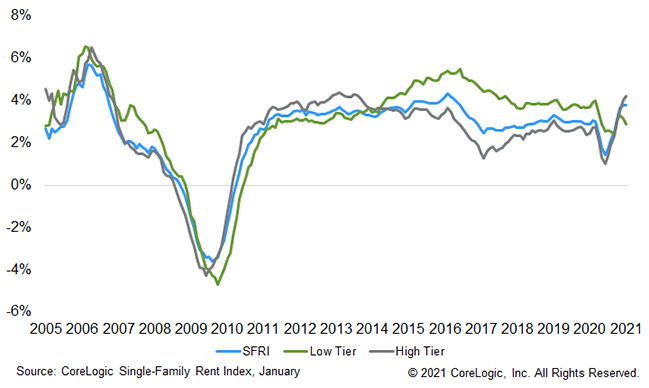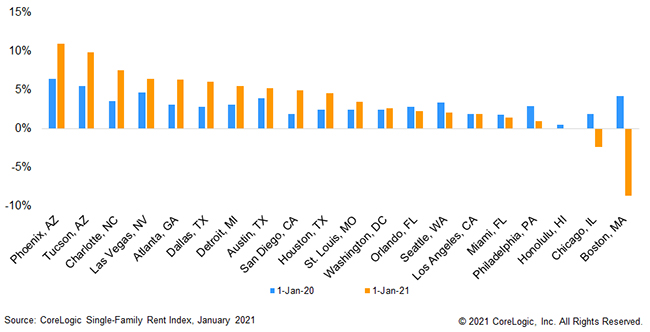
U.S. Single-Family Rents Up 3.8% Year Over Year in January
Overall Single-Family Rent Growth
U.S. single-family rent growth remained strong in January 2021, increasing 3.8% year over year, showing solid improvement from the low of 1.4% reported for June 2020, and up from the 2.9% rate recorded for January 2020, according to the CoreLogic Single-Family Rent Index (SFRI). The index measures rent changes among single-family rental homes, including condominiums, using a repeat-rent analysis to measure the same rental properties over time.
Single-Family Rent Growth by Price Tier
An uneven U.S. job recovery, sometimes called a “K-shaped” recovery, is reflected in the rent price growth of the low- and high-price rent tiers. The low-price tier is defined as properties with rent prices less than 75% of the regional median, and the high-price tier is defined as properties with rent prices greater than 125% of a region’s median rent (Figure 1).
Figure 1: National Single-Family Rent Index Year-Over-Year Percent Change By Price Tier

Unlike the high-price tier, rent growth in the low-price tier remains below pre-pandemic levels as the recession has disproportionately affected lower-wage workers. Rent prices for the low-end tier, increased 2.9% year over year in January 2021, down from 3.7% in January 2020. Meanwhile, higher-priced rentals increased 4.2% in January 2021, up from a gain of 2.5% in January 2020. This was the fastest increase in higher-price rents since August 2013 as prices were pushed up by higher-wage workers who are able to work from home can afford to move to larger homes that have more space.
Metro-Level Results
Figure 2 shows the year-over-year change in the rental index for 20 large metropolitan areas in January 2021. Among the 20 metro areas shown, Phoenix stood out with the highest year-over-year rent growth in January as it has since late 2018, with an increase of 11%, followed by Tucson, Arizona (+9.8%) and Charlotte, North Carolina (+7.6%). Two metro areas experienced annual declines in rent prices: Boston (-8.6%) and Chicago (-2.3%).
Figure 2: Single-Family Rent Index Year-Over-Year Percent Change in 20 Markets

While 7 of the 20 metros shown in Figure 2 had lower rent growth than a year ago, Boston had the largest deceleration in rent growth, showing annual rent growth of 12.9 percentage points lower than in January 2020. The slowdown in Boston rent growth might be attributed to college students choosing not to return to Boston, but instead opting to continue virtual learning elsewhere. Chicago had the second-largest slowdown in rent growth, coming in 4.2 percentage points lower than a year earlier. There were large differences in rents of attached versus detached properties in both Boston and Chicago. While rent prices of detached rentals in Boston decreased by just 0.5%, attached rentals experienced a decrease of 9.1%. Comparatively, Chicago had a 4.2% decrease in attached rentals and a 3.6% increase in detached rentals.
Single-family rents continue to show strength and national rents had a sharp increase compared with a year earlier. With fewer affordable homes available for purchase, and ongoing consumer desire for more space, single-family rental vacancy rates will continue to be squeezed — spurring further increases in rents.
To learn more about the data behind this article and what CoreLogic has to offer, visit https://www.corelogic.com/.







Sign up to receive our stories in your inbox.
Data is changing the speed of business. Investors, Corporations, and Governments are buying new, differentiated data to gain visibility make better decisions. Don't fall behind. Let us help.













Sign up to receive our stories in your inbox.
Data is changing the speed of business. Investors, Corporations, and Governments are buying new, differentiated data to gain visibility make better decisions. Don't fall behind. Let us help.





